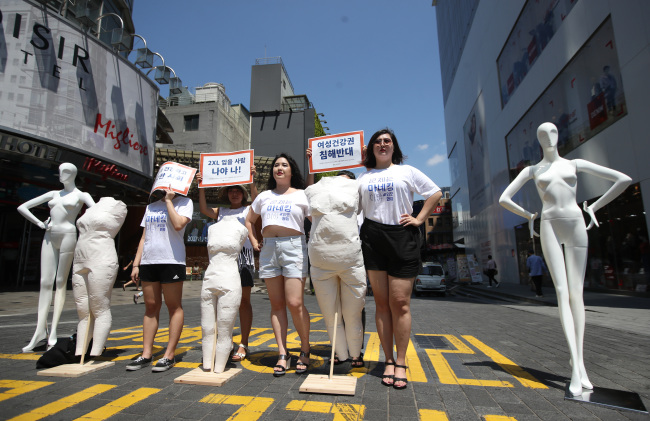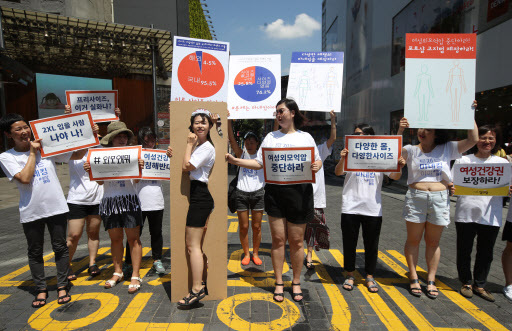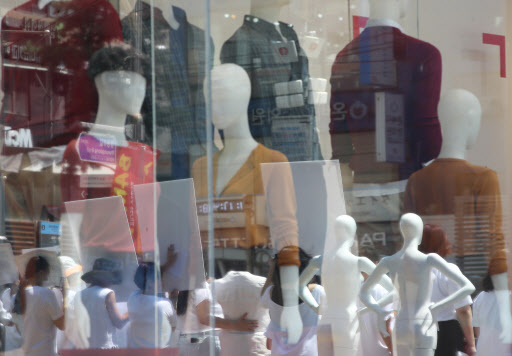Feminists criticize lookism, call for more diversified clothing sizes
By Ock Hyun-juPublished : July 27, 2017 - 18:51
In the United States, South Korea’s first plus-size model Kim Gee-yang was not even considered plus-sized. But in South Korea, people just see her as a “fat woman” unfit to be a fashion model.
“In Korean society, there are categories for only ‘normal’ or ‘average’ people. The rest don’t belong anywhere, and fat people are just mocked. They consider being fat as lazy, disgusting and unhealthy,” Kim told The Korea Herald.
“It is not true and it is none of others’ business,” said Kim, 31, who is a US size 14 and 165 centimeters tall. “It has been a long time since I’ve shopped in Korea because there are not many sizes here I can try on.”
Kim, who debuted as a model in the US in 2010, now owns magazine 66110. It runs articles on fashion issues for plus-size women and sells clothes for them as part of efforts to fight against the country’s long-held beauty norm.
“Being fat is not a problem just like being slim, having short or long hair isn’t a problem.”
“In Korean society, there are categories for only ‘normal’ or ‘average’ people. The rest don’t belong anywhere, and fat people are just mocked. They consider being fat as lazy, disgusting and unhealthy,” Kim told The Korea Herald.
“It is not true and it is none of others’ business,” said Kim, 31, who is a US size 14 and 165 centimeters tall. “It has been a long time since I’ve shopped in Korea because there are not many sizes here I can try on.”
Kim, who debuted as a model in the US in 2010, now owns magazine 66110. It runs articles on fashion issues for plus-size women and sells clothes for them as part of efforts to fight against the country’s long-held beauty norm.
“Being fat is not a problem just like being slim, having short or long hair isn’t a problem.”

On Wednesday, an association of six women’s rights groups criticized clothing companies for using mannequins idealizing too-thin figures and making only limited sizes in clothing, which they said solidifies an unrealistic beauty standard.
According to the report by the Korea Women’s Environmental Network on 31 clothing companies, including FOREVER21, H&M, Uniqulo and MIXXO, 74.2 percent of them failed to offer various sizes -- only retaining three sizes. Of those, 95.5 percent were local brands.
Only 25 percent of the surveyed retailers had an XS size and 30.1 percent had an XL.
In terms of sleeveless shirts, only 11 of 31 brands had an XL size and only seven brands had an XS. As for short skirts, out of 26 brands, six retailers had an XS size or smaller, and only two brands had an XL size and bigger, it said.

They have called for varied body sizes of mannequins and clothing to be showcased by retailers, as well as an act demanding retailers to denote retouched images in their advertisements.
A standard mannequin in South Korea is 175 to 180 centimeters tall, has a waist measurement of 24 inches and a hip measurement of 89 centimeters. But the average woman aged 20 to 24 in the country is 160 centimeters tall and has a waist size of 28 inches and hip size of 92.7 centimeters, according to the Korea Agency for Technology and Standards in 2015.

“It is common to see women who say they could not find items available in their sizes, especially feminine items like skirts,” Ko Kum-sook from KWEN said. “Limited sizes not only spread a distorted standard for beauty, but also make women think that it is their fault to be too heavy.”
“Many women are constantly on a diet, suffering from mental distress and eating disorders,” she said. “More sizes mean women’s health rights better protected.”
In a 2013 study by Samyook University in Seoul that surveyed 233 female university students only 11.5 percent said that they were satisfied with their bodies. On the other hand, 93.5 percent of 154 students who are in the normal range said that they were unhappy with their bodies.
“I used to think about losing weight all the time. When I saw women looking perfect in their clothes in advertising, I tried it on. But when I didn’t look like it, I got disappointed,” said Kim Ah-yeong, a women’s rights activist at Bulggot Femi Action.
Both women and men cannot avoid facing lookism, but it places a heavier burden on women, she said.
“Many men also take interest in taking care of their appearance, but doing that is almost a must for women. It seems like there are stereotypes for women’s looks, such as thin arms and legs, muscular thighs and big breasts.”
Though beauty standards vary all over the world, many other countries also place an emphasis on being skinny. But it is especially pronounced here, a scholar said.
“Limited options for sizes are linked to Korean society putting too much stress on having certain types of looks, which can be seen in many Koreans going under the knife,” said Seol Dong-hoon, sociology professor at Jeonbuk University.
According to a survey on 459 men and women in their 20s by Univ 20 magazine and Banobagi Plastic Surgery in 2016, 46.4 percent of them said they had received plastic surgery. Of them, 44.5 percent said they had done so because they had been envious of others’ looks.
In 2007, legislation was introduced in Korea to make it mandatory for clothing manufacturers to make various sizes including big ones, but failed to pass through the National Assembly.
In 2015, France enforced a law prohibiting unhealthy models on its runways and requiring advertisers to indicate in text in cases where images of models were digitally retouched. The US proposed a similar bill this year.
By Ock Hyun-ju (laeticia.ock@heraldcorp.com)
-
Articles by Ock Hyun-ju



![[AtoZ into Korean mind] Humor in Korea: Navigating the line between what's funny and not](http://res.heraldm.com/phpwas/restmb_idxmake.php?idx=644&simg=/content/image/2024/04/22/20240422050642_0.jpg&u=)
![[Exclusive] Korean military set to ban iPhones over 'security' concerns](http://res.heraldm.com/phpwas/restmb_idxmake.php?idx=644&simg=/content/image/2024/04/23/20240423050599_0.jpg&u=20240423183955)



![[Graphic News] 77% of young Koreans still financially dependent](http://res.heraldm.com/phpwas/restmb_idxmake.php?idx=644&simg=/content/image/2024/04/22/20240422050762_0.gif&u=)

![[Herald Interview] Why Toss invited hackers to penetrate its system](http://res.heraldm.com/phpwas/restmb_idxmake.php?idx=644&simg=/content/image/2024/04/22/20240422050569_0.jpg&u=20240422150649)





![[Exclusive] Korean military to ban iPhones over security issues](http://res.heraldm.com/phpwas/restmb_idxmake.php?idx=652&simg=/content/image/2024/04/23/20240423050599_0.jpg&u=20240423183955)



![[Today’s K-pop] Ateez confirms US tour details](http://res.heraldm.com/phpwas/restmb_idxmake.php?idx=642&simg=/content/image/2024/04/23/20240423050700_0.jpg&u=)